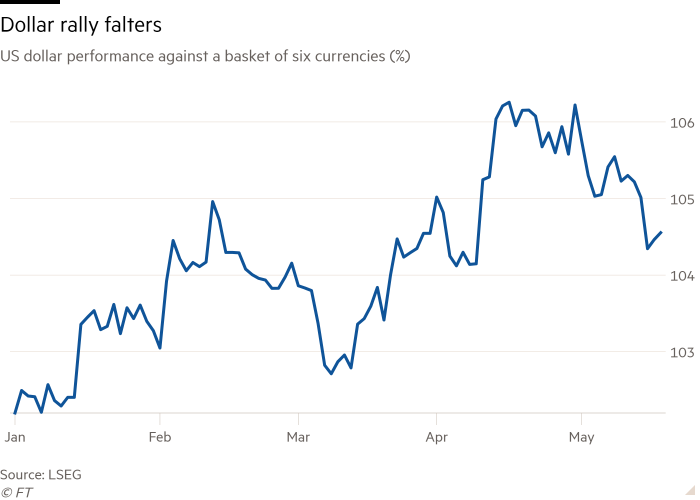Unlock Editor’s Digest for free
Rula Khalaf, editor of the FT, picks her favorite stories in this weekly newsletter.
The US dollar’s gains this year have gone into reverse as investors argue that falling inflation in the world’s largest economy will give the Federal Reserve more room to cut interest rates.
The greenback, which had gained as much as 5 percent this year through mid-April against a basket of currencies, is now on track for its first drop in 2024 after the pace of consumer price growth eased in line with forecasts on Wednesday.
The reading, after months of higher-than-expected inflation, helped ease concerns that the Fed may not be able to cut rates significantly this year, or may even have to raise them again from 23-year highs to control growth. prices.
“FED rates are more important in markets at the moment,” said Athanasios Vamvakidis, head of G10 currency strategy at Bank of America.
“Inflation data this week meant that another rate hike is not on the cards. . . now it’s a matter of time before they start cutting back,” he added.
Investors have taken a serious look at interest rates this year as US inflation rose in February and March. That helped traders sharply lower their bids for a rate cut, while hedge funds snapped their bearish bets against a dollar revival.
But after readings on Wednesday showed inflation falling to 3.4 percent, traders raised bets on the Fed cutting rates twice by a quarter point this year.
On Wednesday, the dollar experienced its worst day of the year. Despite a partial rebound later in the week, it is still down 1.4 percent this month.

Analysts say the recent softening of US data, which began earlier this month when a critical jobs report missed expectations, could be the start of a prolonged period of dollar weakness, although given the economy is still relatively strong, any decline could take time
“I think we’re at an inflection point, but we’re going to hang around here for some indefinite period of time,” said Keith Jaques, currency strategist at Société Générale. “Dollar bulls lack arguments for further growth.”
The dollar weakened as US government borrowing costs fell, helping lift stock markets in the US, Germany and the UK to record highs this week.
The benchmark yield on 10-year U.S. Treasuries — a key driver of global asset price gains — fell to 4.3 percent from 4.7 percent late last month as traders bid up more than one Fed rate cut in this year. Yields fall as prices rise.
The dollar’s weakness this month comes after a recent surge in bets against the currency among hedge funds, which began selling the currency last month and are “firmly short,” according to Sam Hewson, head of foreign exchange sales at Citigroup.
However, asset managers remain overweight, Hewson said. If their positioning differs from that of hedge funds, “historical patterns suggest. . . it’s best to keep it short,” he added.
The recent moves are welcome news for central bankers around the world, who are struggling to cope with rising US Treasury yields and a sustained strengthening of the dollar. This was especially the case in Japan, where the finance ministry is believed to have sold about $59 billion in recent weeks to prop up its ailing currency.
“A weak dollar makes life a little easier for Tokyo,” said Chris Turner, currency strategist at ING, pointing out that the Japanese currency is more sensitive to shifts in U.S. exchange rate expectations than to rising borrowing costs in its own market.
Evaporating expectations of a possible US rate hike could also increase room for maneuver at the European Central Bank, which is expected to start cutting interest rates in June.
ECB President Christine Lagarde made it clear that Europe could start reducing borrowing costs before the Fed. But if the U.S. central bank were to raise rates again this year while European rates were falling, it could put significant pressure on the bloc’s currency and risk stoking inflation.
“The latest US data is good news for the ECB,” said BofA’s Vamvakidis. “This means the ECB can cut in June without worrying too much about a weaker euro.”